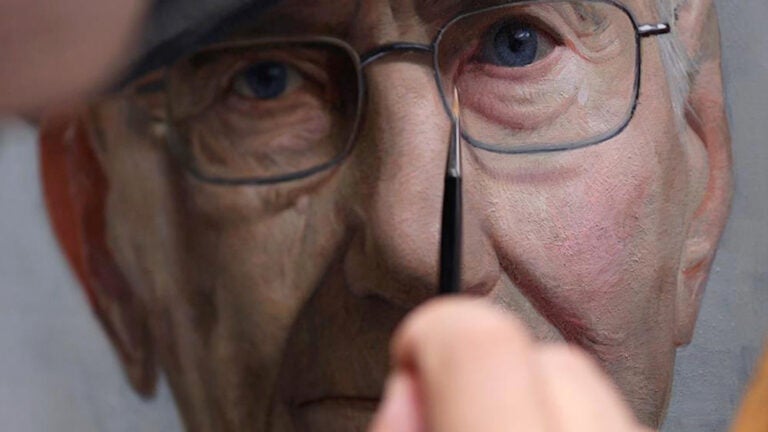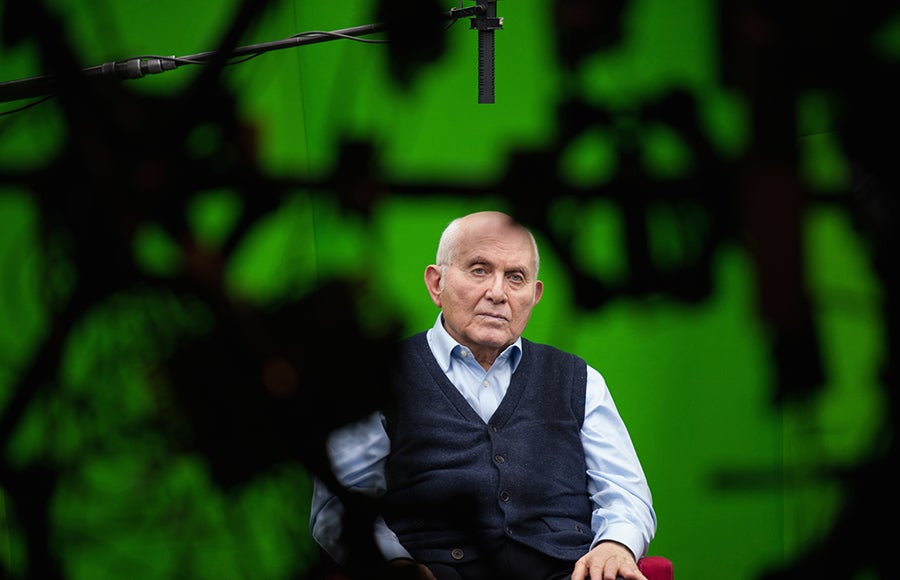
Powerful art exhibition unveils personal stories of surviving the Holocaust
Painter David Kassan has sat with survivors of the Holocaust for countless hours during the past five years, carefully listening to their stories of pain, grief, resilience and quiet victory. He used that deep knowledge of their lives to create his strikingly personal portraits of more than a dozen survivors, which are displayed in a new art exhibition presented by the USC Fisher Museum of Art and USC Shoah Foundation – The Institute for Visual History and Education.
The show, “Facing Survival | David Kassan,” running through Dec. 7 at the Fisher Museum, pairs dozens of the artist’s poignant and lifelike portraits with a life-size interactive display from USC Shoah Foundation that allows visitors to ask survivors, including several featured in Kassan’s artwork, about their life before, during and after the genocide, and to hear their prerecorded replies.
“We are taking art and using it to honor human memory at times when it is so difficult because it’s so painful,” said Selma Holo, director of the USC Fisher Museum of Art and professor of art history at the USC Dornsife College of Letters, Arts and Sciences. “Art is a kind of knowledge, and when you put it together with other kinds of knowledge and technology, you create something very special.”
The exhibition is a culmination of Kassan’s residency with the museum and USC Shoah Foundation that started in 2017, as well as a showcase of the realist painter’s ongoing efforts to capture both the appearance and essence of people who survived the Holocaust. Like the thousands of hours of video interviews with genocide survivors captured and maintained by USC Shoah Foundation, Kassan views his work as a form of testimony about their experiences.
“They are so different — it’s the spectrum of humanity,” Kassan said. “Some people say, ‘Oh, it was just a thing that happened.’ Some people still think about the camps every day. It’s a personal story that can speak to somebody. Maybe it can speak to a Holocaust denier who now sees the humanity in these people.”

Pinchas Gutter is recorded for USC Shoah Foundation’s Dimensions in Testimony project at the USC Institute for Creative Technologies. (Photo: Kim Fox.)
The exhibit pairs Kassan’s portraits with videos from Dimensions in Testimony, USC Shoah Foundation’s interactive interview project that has collected more than 20 life stories from Holocaust survivors. Visitors to the exhibit at the art museum can ask questions of some of the people portrayed in Kassan’s portraits, and then listen to their prerecorded answers.
Pinchas Gutter is one of the people whose likeness and story are part of the exhibit. His recollections in the videos range from the life-changing great events of his life, such as his escape through the gates of Theresienstadt concentration camp, to the small details of memories from his imprisonment, such as the water steeped with acorns he subsisted on at Majdanek concentration camp, and the way his twin sister’s golden braided hair shimmered in the sun as she was separated from him by the Nazis, who later murdered her and the rest of his family in Majdanek’s gas chambers.
Holo is hopeful that visitors will take time to engage with each portrait and explore the interactive display. Statistics about the Holocaust — such as the millions of deaths that occurred — can be difficult to comprehend or digest on their own, she said, but practicing what she calls “slow looking,” including hearing and seeing personal stories, can help people develop meaning around the genocide.
“Storytelling is extremely important. Things happen randomly, but if somehow you piece it together into a story, people have a better chance of it imprinting on them. We’re honoring the old way of telling stories and then joining it with these new techniques that can make it even more accessible.”
Visit USC News for more on the story, including a menu of related events >>